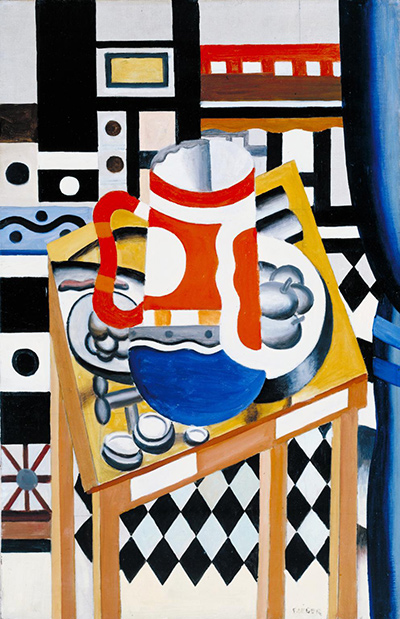Still Life with a Beer Mug is a Fernand Leger painting from 1921–2 which is now a part of the highly significant Tate collection in the UK.
By this point in his career, Leger had already been through several different periods where his cubist approach developed and adapted. You will see from The City, for example, where he concentrated on urban scenes over several years. At this point he was working on still life paintings, capturing a beer mug sat on a small coffee table. The content reminds us of the work of Juan Gris and Georges Braque, both in style and content. See, for example, the likes of Fruit Dish and Glass and Violin and Candlestick by Braque, or Bottle, Newspaper and Fruit Bowl and Violin and Glass by Juan Gris.
The mug found here is a traditional Bavarian piece, similar to what you might imagine people using at the Oktoberfest. Leger captures a long curved handle and leaves a rounded bottom, by making use of the artistic license offered by the Cubist artistic style. Some of his cubist paintings are so abstract that it can be hard to identify individual elements of the piece but this work is much easier, with elements clearly appearing to the eye pretty much immediately.
We can see elements of the room's decor in the background, a small open window with perhaps the rail across a balcony. In the foreground is a small table, with perspective skewed beyond a realistic manner. There are then additional items added to the table around the central mug. These items include butter pots, a knife and a plate for fruit, suggesting perhaps a relaxing lunch as accompanied by beer, rather than coffee or tea. Leger used bright colours in this painting, having restricted himself to far more subdued colour schemes earlier in his career - could this have been the result of a more positive outlook on life, with war passing and a better future now appearing on the horizon? Alternatively, it could simply have been the normal artistic development that most artists go through over time.
Artist Leger mixes up perspective in this scene, with a geometric display of tiles arranged below the table, which itself is shaped in a way that goes against what our eyes are accustomed to seeing in real life. Artists loved Cubism for the opportunities that it allowed artists to bend reality, just as Surrealism would also offer the likes of Dali and Ernst. The content here is less ambitious, but entirely charming, being a simple domestic scene that allows us to imagine being in this bright and personal environment.




